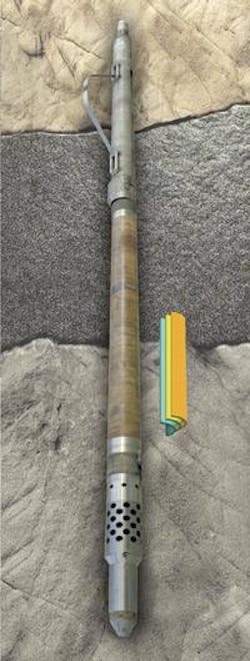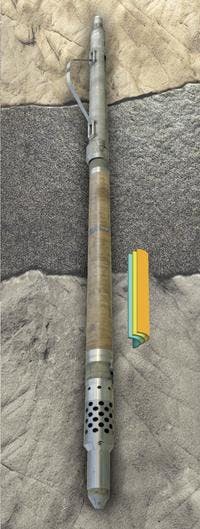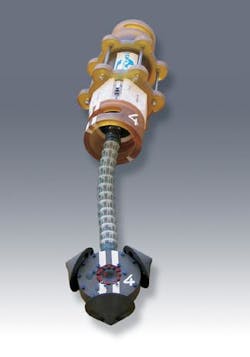Geosciences
Public core
One of the most useful and difficult pieces of geologic information to gather is rock core. Unlike seismic data, which is at best a fifth- or sixth-order truth, cores are a second-order truth and much closer to the first-order truth of the in-situ reservoir. Drill cuttings are also a second-order truth, but are more limited due to physical and chemical alteration.
Larger companies maintain core libraries as part of their research efforts and as reference tools for the areas where they are actively exploring. Access to corporate core libraries is limited, if available at all. Public core libraries are more limited in number and scope.
That limitation has now been eased with the opening of a new public core repository last month in Houston, Texas. The Houston Research Center (HRC) is operated by The Bureau of Economic Geology (BEG) at The University of Texas at Austin and houses about 500,000 boxes of core samples and rock cuttings, along with a technical library of more than 50,000 geoscience and petroleum engineering items.
The HRC was created in late 2002 when BP donated the 110,000-sq-ft building, 12 acres of land, and 400,000 boxes of core and cuttings. Occidental Petroleum added nearly 50,000 boxes of rock material. Unocal donated a technical library. Other major contributors and partners include Marathon, the US Department of Energy, and the National Science Foundation.
MREX logging
Baker Atlas has introduced its Magnetic Resonance Explorer (MREX) service. MREX acquires higher quality nuclear magnetic resonance (NMR) data in less time than earlier NMR logging systems, Baker says. The tool measures porosity, fractional volumes of bound and moveable fluids, and formation permeability.
The tool incorporates a side-looking antenna design, providing high-quality data regardless of mud conductivity, borehole size, or deviation. It uses a gradient magnetic field to provide NMR data for formation evaluation and fluid analysis. The instrument operates at multiple frequencies for faster logging and multiple, simultaneous, NMR experiments in a single pass.
null
Flexible VR
Fakespace Systems completed the world's first reconfigurable, immersive visualization system to include both active and passive stereoscopic technology. Designed for Purdue University's new Envision Center for Data Perceptualization, the system uses the reconfigurable FLEX platform. The system includes a custom display and a dual-channel PowerWall.
The Center is a 5,600-sq-ft theater that seats up to 50 people for review of tera-byte sized, computer-generated models. FLEX will be positioned in a 30-ft wide flat theater for large group viewing and interaction. For full immersion, the display can be moved to a CAVE-like environment with floor projection. Image generators include an Onyx4 and a Tezro workstation from SGI. ;
TECHNOLOGY
Reservoir potential
Roxar has launched Tempest 6.1, a reservoir simulation tool with 2D and 3D visualization capabilities. It can simulate physical processes including black oil, compositional, dual porosity, steam, coal bed methane, and polymer injection.
It has four integrated modules:
- Tempest-MORE: a full-field simulator
- Tempest-View: simulation pre- and post-processing
- Tempest-PVTx: matches fluid properties descriptions to laboratory data
- Tempest-Venture: economic evaluation and risk analysis.
The simulator engine is coded in C++ and the user interface is in Java.
On-demand processing
Landmark Graphics is offering Deep Computing Capacity on Demand (DCCD), a subscription seismic processing service in conjunction with IBM. By accessing DCCD, Landmark will provide supercomputing power for seismic processing and scalable access to information storage.
The company claims that customers will be able to process larger seismic volumes and receive faster project turnaround using this service. It requires no client capital investment for high-performance computing and is valuable for pre-stack imaging, using ProMAX, SeisSpace, and other technologies.
EXPLORATION
Danish survey
WesternGeco has completed a Q-Marine survey for the Danish Oil and Natural Gas (DONG) over Siri field in the North Sea. The 128 sq km, high-resolution survey was shot over a 1996 survey and was conducted in two phases. First, the Western Pride, towing six 3,200-m streamers at 100-m separation, repeated the 1996 survey. The vessel then increased data density with interleaved passes to enhance imaging. The survey includes 4D processing of the older data.
GoM nodes
CGG Services has completed a deepwater seabed seismic acquisition project in the Gulf of Mexico. The project used CGG's autonomous node technique for field development seismic. Autonomous nodes were deployed along the Sigsbee Escarpment in a variety of conditions and in water depths ranging over 2,000 m.
"The addition of an integrated autonomous node seabed solution to CGG Services' seabed cable solutions allows us unprecedented flexibility in customizing solutions to our clients' needs," said Jonathan Miller, CEO of CGG Americas.
null
Norway surveys
Hydro has awarded WesternGeco the acquisition and processing of two 3D surveys over the Oseberg field to repeat heritage surveys of over 906 and 191 sq km, respectively. The Geco Topaz will conduct the surveys towing six 3,600-m streamers using spreads of 750 m and 500 m.
Statoil awarded WesternGeco a 640 sq km 3D/4D survey over the Visund field in the Tampen area offshore Norway. The Western Pride will acquire data using 10 5,000-m streamers spread to 675 m.


